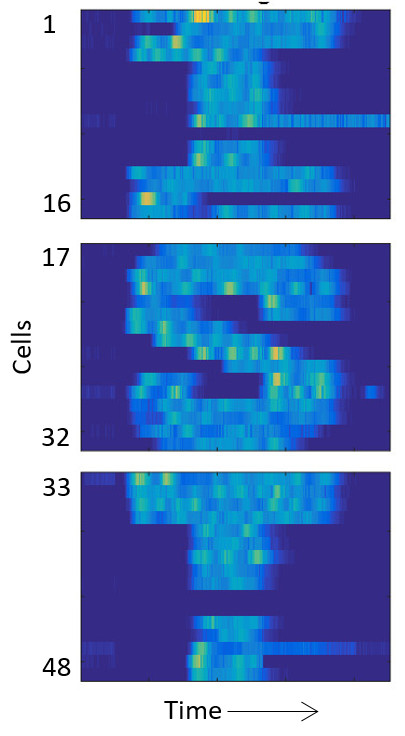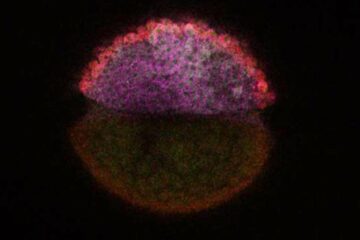Virtual Reality for Bacteria

Individual cells are digitally guided along pre-specified trajectories of fluorescent gene expression. 48 Escherichia coli cells are arranged vertically in the image. Time moves on towards the right. Credit: Remy Chait
Scientists at the Institute of Science and Technology Austria (IST Austria) have managed to control the behavior of individual bacteria by connecting them to a computer. The interdisciplinary team including experimental biologist Remy Chait and mathematician Jakob Ruess (now at the Institut Pasteur and Inria Saclay in France) as first authors of the study, as well as Professors Calin Guet and Gasper Tkacik used the setup to build a genetic circuit that is partly living and partly digital.
Their experiment, in which they made gene expression in bacteria oscillate, and controlled the patterns of oscillation by adjusting digital communication between individual bacteria, serves as a proof of concept. A potential application of such bio-digital hybrid technology could make it possible to “debug” complex biological systems in the same way complex computer codes are debugged: by testing each part individually while simulating its surroundings in a form of virtual reality.
When synthetic biologists want to engineer a microorganism that can fulfill a certain task, let’s say produce a cancer drug or an antibiotic as part of its metabolic cycle, they usually have to make a significant number of changes to the original organism. Each of these changes has several effects which might interfere with the effects of all other changes, altering the final result.
“Even if you understand what the different parts do, you don’t know what happens when you put them together,” explains Remy Chait. “There is feedback between them that makes the behavior of the full circuit unpredictable.”
A potential solution to this problem comes from software development and is called unit and integration testing. In this approach each component is tested individually and its interaction with the surroundings is studied. The best way to do this is to simulate the surroundings in a virtual space and to let the component interact with this virtual world. It is this method that the researchers now propose to apply also to biological systems.
“Biological systems are complex and we would benefit if we could debug them like a computer code. In unit and integration testing you simulate the environment and plug each of the components in separately to verify that they function as intended. Then you combine them in pairs and start all over. In this way you will see at which point feedback and interference start to disturb the system, and adjust it appropriately” Remy Chait explains. By iterating this method the virtual part could be steadily reduced until the system is fully biological again – and has the desired function!
The researchers demonstrated the feasibility of bio-digital hybrids with a bio-digital oscillator. In their setup, modified E.coli cells produce a protein that fluoresces blue-violet. This colored light forms the interface with the digital side. Every six minutes, the computer measures how much light the cell produces, and accumulates a virtual signal molecule in proportion to it. When the signal exceeds a certain threshold, production of the fluorescent protein by the cell is switched off.
This is done by a projector which projects red or green light as “off” or “on” signal onto the light-sensitive cells and thereby links the digital component back to the living parts of the circuit. “The cells are interacting with the simulated environment. What they do influences what the computer does and what the computer does influences the reaction of the cells. If you know Star Trek, you have certainly heard of the Holodeck. What we have built is essentially a simple Holodeck for genes of microorganisms.”
When the researchers tested their hybrid circuits, the population of cells glowed in blue violet – and the glow oscillated, albeit with variations between the individual bacteria. But the researchers wanted the bacteria to oscillate in synchrony, so they altered the digital component and set up a virtual communication network between the bacteria. In this set-up, some of the virtual signal is distributed between neighbors and the group of bacteria display different types of collective oscillation.
A different application of the researcher’s platform is feedback control of individual cells that guides them along pre-specified trajectories of fluorescent gene expression. In this way, they could make a group of cells trace pictures or letters over time (see illustration).
IST Austria
The Institute of Science and Technology (IST Austria) is a PhD granting research institution located in Klosterneuburg, 18 km from the center of Vienna, Austria. Inaugurated in 2009, the Institute is dedicated to basic research in the natural and mathematical sciences. IST Austria employs professors on a tenure-track system, postdoctoral fellows, and doctoral students. While dedicated to the principle of curiosity-driven research, the Institute owns the rights to all scientific discoveries and is committed to promote their use. The first president of IST Austria is Thomas A. Henzinger, a leading computer scientist and former professor at the University of California in Berkeley, USA, and the EPFL in Lausanne, Switzerland. The graduate school of IST Austria offers fully-funded PhD positions to highly qualified candidates with a bachelor’s or master’s degree in biology, neuroscience, mathematics, computer science, physics, and related areas. See www.ist.ac.at
Source:
Remy Chait, Jakob Ruess et al: “Shaping bacterial population behavior through computer-interfaced control of individual cells”
Nature Communications, 2017
doi:10.1038/s41467-017-01683-1
https://www.nature.com/articles/s41467-017-01683-1
https://www.nature.com/articles/s41467-017-01683-1 Article in Nature communications
http://ist.ac.at/nc/en/news-media/news/news-detail/article/virtual-reality-for-b… Press release on the website of IST Austria
http://ist.ac.at/research/research-groups/guet-group/ Research group of Prof. Guet
http://ist.ac.at/en/research/research-groups/tkacik-group/ Research group of Prof. Tkačik
Media Contact
All latest news from the category: Interdisciplinary Research
News and developments from the field of interdisciplinary research.
Among other topics, you can find stimulating reports and articles related to microsystems, emotions research, futures research and stratospheric research.
Newest articles

Attosecond core-level spectroscopy reveals real-time molecular dynamics
Chemical reactions are complex mechanisms. Many different dynamical processes are involved, affecting both the electrons and the nucleus of the present atoms. Very often the strongly coupled electron and nuclear…

Columbia researchers “unzip” 2D materials with lasers
The new technique can modify the nanostructure of bulk and 2D crystals without a cleanroom or expensive etching equipment. In a new paper published on May 1 in the journal…

Decoding development: mRNA’s role in embryo formation
A new study at Hebrew University reveals insights into mRNA regulation during embryonic development. The study combines single-cell RNA-Seq and metabolic labeling in zebrafish embryos, distinguishing between newly-transcribed and pre-existing…





















